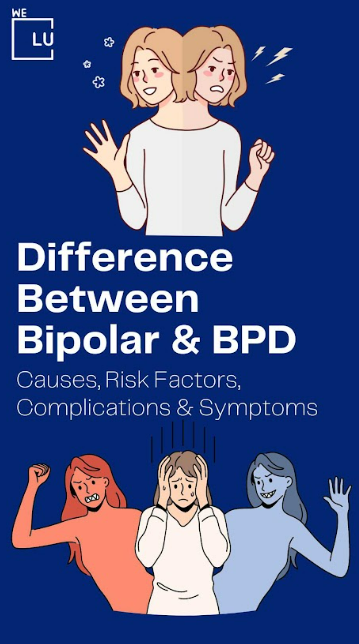BPD vs Bipolar
Bipolar disorder (BPD) and borderline personality disorder (BPD) are two distinct mental health conditions that share some similarities but also have significant differences. While both disorders involve mood disturbances, understanding the specific characteristics and diagnostic criteria is essential to provide appropriate support and treatment. This article aims to clarify the differences between BPD and bipolar disorder, enabling individuals, loved ones, and healthcare professionals to make informed decisions regarding diagnosis and treatment.
Characteristics of Bipolar Disorder vs BPD
Bipolar disorder and borderline personality disorder (BPD) are distinct mental health conditions with different characteristics. Here are some key difference between bipolar and BPD:
- Mood Episodes: Bipolar disorder is characterized by distinct episodes of mania and depression. Individuals with bipolar disorder experience periods of intense elevated mood (mania or hypomania) alternating with periods of depression. In contrast, individuals with BPD may experience mood swings but are typically more rapid and reactive to interpersonal stressors.
- Duration of Mood States: In bipolar disorder, mood episodes can last for days, weeks, or even months. On the other hand, mood fluctuations in BPD can be shorter, often lasting hours to a few days.
- Mood Triggers: Bipolar disorder episodes can occur without any external triggers, and the shifts in mood are often unrelated to specific events. In BPD, mood swings are more closely tied to interpersonal relationships and can be triggered by perceived or real abandonment, rejection, or conflict.
- Self-Image and Identity: Individuals with bipolar disorder typically have a stable sense of self and identity. In contrast, individuals with BPD often struggle with a shifting self-image, feelings of emptiness, and an unstable sense of identity.
- Impulsivity and Self-Destructive Behaviors: BPD is more commonly associated with impulsivity, self-destructive behaviors, and risk-taking. These behaviors include self-harm, substance abuse, reckless driving, or impulsive spending. While individuals with bipolar disorder may engage in impulsive behaviors during manic episodes, they are not typically a consistent feature.
- Treatment Approaches: Treatment approaches for bipolar disorder, and BPD differ. Bipolar disorder is primarily managed with mood-stabilizing medications and sometimes supplemented with psychotherapy. BPD often involves a combination of psychotherapy, such as dialectical behavior therapy (DBT), and may include medication for co-occurring conditions.

Skip To:
Learn More:
BPD vs Bipolar Disorder Fact Sheet
Bipolar Disorder
- Mood Episodes: Characterized by distinct episodes of mania/hypomania and depression.
- Duration: Mood episodes can last for days, weeks, or months.
- Triggers: Episodes can occur without external triggers, and mood shifts are often unrelated to specific events.
- Self-Image: Individuals typically have a stable sense of self and identity.
- Impulsivity: Impulsive behaviors may occur during manic episodes.
- Treatment: Mood-stabilizing medications are often prescribed, along with psychotherapy.
Borderline Personality Disorder (BPD)
- Mood Fluctuations: Rapid and reactive mood swings often trigger interpersonal stressors.
- Duration: Mood shifts are shorter, lasting hours to a few days.
- Triggers: Mood swings are closely tied to interpersonal relationships and are triggered by abandonment, rejection, or conflict.
- Self-Image: Individuals struggle with a shifting self-image and an unstable identity.
- Impulsivity: Impulsive and self-destructive behaviors, such as self-harm or substance abuse, are more common.
- Treatment: Dialectical behavior therapy (DBT) and other forms of psychotherapy are often used, along with medication for co-occurring conditions.
BPD Treatments
BPD was initially believed to be incurable. However, this isn’t the case because we know that BPD can be effectively treated. Therapy helps many BPD patients who are distressed to feel better.
Dialectical Behavioral Therapy
Psychologist Marsha Linehan developed dialectical behavioral therapy (DBT). This treatment teaches you to deal with challenging and overwhelming emotions. The most popular method of treating BPD is DBT. Each skill set aids in the reduction of BPD symptoms.
Dialectical behavioral therapy imparts four key skill sets to its patients:
- Interpersonal effectiveness.
- Emotional regulation.
- Distress tolerance.
- Mindfulness.
Mentalization-Based Therapy
Mentalization-based therapy helps you develop an awareness of your inner state. In mentalization-based treatment, fostering empathy for other people’s experiences is a key goal.
According to research published in 2018, this therapy may dramatically lessen the severity of BPD symptoms and co-existing diseases while enhancing the quality of life. However, the authors point out that additional study is still required.
Medication
No single medication is effective for BPD, but medications may relieve some symptoms.
As an illustration, medicines may support mood stabilization. Discuss your symptoms with a doctor if you believe medication could help you.
End the Emotional Pain. Get Your Life Back.
Feeling Depressed, Anxious or Struggling with Mental Health Illness? Get Safe Comfortable Mental Health Dual Diagnosis High-Quality Therapy From Counselors That Care. Begin Your Recovery Now.
Hotline: (509) 348-4077

Statistics
Bipolar and Borderline Personality Disorder (BPD) are different mental health conditions. They can have some of the same symptoms but are also very different. Bipolar disorder affects about 2.4% of the world’s population, and it is thought that BPD affects about 1-2% of the world’s population. Bipolar disorder usually appears in late adolescence or early adulthood, with 25 being the average age of onset. On the other hand, BPD usually starts in early adulthood, with the average age of onset being 18. Regarding differences between men and women, bipolar disorder affects both men and women in the same way.
On the other hand, BPD is more often diagnosed in women than men, with about a 3:1 ratio of women to men. Both conditions have a high risk of suicide, but people with bipolar disorder have a higher risk (15–20%) than those with borderline personality disorder (10%). Bipolar disorder and BPD often go hand in hand with other mental health problems. This shows the importance of getting a correct diagnosis and thorough treatment.
2.4%
the global prevalence of the bipolar disorder
Source: CDC
25 years
Bipolar disorder typically emerges in late adolescence or early adulthood
Source:
3:1
BPD is more commonly diagnosed in females
Source:
Get Help. Get Better. Get Your Life Back.
Searching for Accredited Dual Diagnosis Mental Health Centers Near You?
Even if therapy failed previously, or are in the middle of a difficult crisis, we stand ready to support you. Our trusted behavioral health specialists will not give up on you. When you feel ready or just want someone to speak to about counseling alternatives to change your life call us. Even if we cannot assist you, we will lead you to wherever you can get support. There is no obligation. Call our hotline today.
FREE 24/7 Dual Diagnosis Mental Health Services HotlineCan you have BPD and Bipolar together?
Yes, it is possible to have both Bipolar Disorder and Borderline Personality Disorder (BPD) simultaneously. It’s not unusual for these two things to happen simultaneously. Research shows that people with BPD are more likely also to have bipolar disorder than the general population as a whole.
Having both conditions can be hard because signs of bipolar disorder, like mood swings and acting on impulses, can also be signs of BPD. This can make it harder to diagnose and plan a treatment. People with symptoms of both disorders should see a doctor for a full evaluation and the right treatment for both. A personalized treatment plan may include medication, therapy, and psychosocial support to help manage symptoms and improve overall health.
Comfortable Facilities & Amenities
High-Quality Mental Health Services & Behaviroal Health Substance Abuse Treatment
Rehab Centers TourRenowned Mental Health Centers. Serene Private Facilities. Inpatient Rehab Programs Vary.
Mental Health Helpline: (509) 348-4077Proven recovery success experience, backed by a Team w/ History of:
15+
Years of Unified Experience
100s
5-Star Reviews Across Our Centers
10K
Recovery Success Stories Across Our Network
- Low Patient to Therapist Ratio
- Comprehensive Dual-Diagnosis Treatment
- Complimentary Family & Alumni Programs
- Coaching, Recovery & Development Events
- Comfortable Onsite Medical Detox Center
Do I Have BPD or Bipolar Quiz (Bipolar vs BPD Test)
Welcome to the BPD vs Bipolar Test! This test is designed to help you gain a preliminary understanding of whether you may exhibit symptoms more aligned with Borderline Personality Disorder (BPD) or Bipolar Disorder. Please keep in mind that this test is not a substitute for professional evaluation and should be used for informational purposes only.
*By taking this free quiz, you may obtain your results online and in your email box. You’ll have the opportunity to opt-in to learn more about your symptoms, talk to a mental health consultant and join our newsletter. Rest assured your information is private and confidential. Results, consultations and assessment are provided without any cost to you and without any obligation. If you do not wish to provide your contact information, you may omit it during your quiz. Thank you for opting in and participating. To you best of health.
Treating Bipolar and Borderline Personality Disorder
Bipolar and Borderline Personality Disorder (BPD) are usually treated with medicine, therapy, and social support. Here are some of the most common ways to treat each condition:
Bipolar Disorder
- Medication: Mood stabilizers, antipsychotics, and antidepressants may be given to control mood swings, keep moods stable, and lessen the symptoms of depression or mania.
- Psychotherapy: Psychoeducation, cognitive-behavioral therapy (CBT), and interpersonal and social rhythm therapy (IPSRT) can help people understand and control their symptoms, come up with ways to deal with them, and improve their relationships with other people.
- Lifestyle changes, such as getting enough sleep, dealing with stress, regular exercise, and not using drugs, can help stabilize mood and reduce the number and severity of episodes.
Borderline Personality Disorder
- Dialectical Behavior Therapy (DBT): DBT is the best way to treat BPD. It teaches people how to control their emotions, deal with stress, improve their relationships with others, and feel better about themselves.
- Schema-Focused Therapy: This therapy helps people figure out and change bad ways of thinking and acting that lead to BPD symptoms.
- Medication: There are no approved medications for BPD, but some may be given to help with other symptoms, such as depression, anxiety, or acting on impulses.
- Group therapy: People with BPD can get support, validation, and a sense of community from group therapy, like DBT skills training groups or general psychotherapy groups.
World-class, Accredited, 5-Star Reviewed, Effective Mental Health Dual Diagnosis Programs. Complete Integrated Inpatient Rehab with Free Post Discharge Therapy Planning.
Hotline: (509) 348-4077End the Emotional Pain Rollercoaster. Gain Stability & Happiness Through Recovery Treatment. Start Mental Health Counseling Today. Get Free No-obligation Guidance by Behaviroal Health Specialists Who Understand Mental Health Recovery.
Popular BPD vs Bipolar FAQs
-
Which is worse bipolar or BPD?
It is not accurate or helpful to categorize mental health disorders as “worse” or “better” than others. Bipolar Disorder and Borderline Personality Disorder (BPD) are distinct conditions with their own unique symptoms, challenges, and treatment approaches. Both disorders can significantly impact an individual’s life and well-being.
Bipolar Disorder involves extreme mood swings, alternating between periods of depression and mania or hypomania. These episodes can significantly disrupt daily functioning and require appropriate treatment and management.
On the other hand, BPD is characterized by unstable emotions, self-image, and interpersonal relationships. Individuals with BPD may struggle with intense emotional reactions, impulsive behaviors, and a fear of abandonment.
Both disorders can cause distress and impair functioning, but the impact varies from person to person. It’s important to remember that every individual’s experience with a mental health disorder is unique, and what may be challenging for one person may be different for another.
8 Steps & Tips for Maintaining Your Mental Wellbeing Informative Video
Video Script
8 Steps for Mental Wellbeing & How To Improve Mental Health In The Workplace
- Staying Positive
- Practicing Gratitude
- Taking Care of Your Physical Health
- Connecting With Others
- Developing a Sense of Meaning and Purpose in Life
- Developing Coping Skills
- Meditation
- Relaxation Techniques
Experience Transformative Recovery at the We Level Up Treatment Center.
See our authentic success stories. Get inspired.
Get the help you deserve.



Start a New Life
Begin with a free call to a behavioral health treatment advisor. Learn more about our dual-diagnosis programs. The We Level Up treatment center network delivers recovery programs that vary by each treatment facility. Call to learn more.
- Personalized Care
- Caring Accountable Staff
- World-class Amenities
- Licensed & Accredited
- Renowned w/ 5-Star Reviews
We’ll Call You
Search We Level Up WA Mental Health BPD vs Bipolar, Understanding the Difference Between Bipolar and Borderline Personality Disorder Topics & Resources
Sources
- Bipolar disorder. (2016).
https://www.nimh.nih.gov/health/topics/bipolar-disorder/index.shtml Learn More: BPD vs Bipolar - Bipolar disorder. (2017).
https://www.nami.org/Learn-More/Mental-Health-Conditions/Bipolar-Disorder Learn More: BPD vs Bipolar - Bipolar disorder (cont’d). (n.d.).
https://adaa.org/understanding-anxiety/related-illnesses/bipolar-disorder-2 Learn More: BPD vs Bipolar - Bipolar disorder. (n.d.).
https://secure2.convio.net/dabsa/site/SPageServer/?pagename=education_bipolar Learn More: BPD vs Bipolar - Borderline personality disorder. (2017).
https://www.mentalhealth.gov/what-to-look-for/personality-disorders/borderline-personality-disorder Learn More: BPD vs Bipolar - Borderline personality disorder. (2017).
https://www.nimh.nih.gov/health/topics/borderline-personality-disorder/index.shtml Learn More: BPD vs Bipolar - Borderline personality disorder. (n.d.).
https://www.nimh.nih.gov/health/publications/borderline-personality-disorder/index.shtml Learn More: BPD vs Bipolar - Duckworth, K. (2017). Borderline personality disorder and bipolar disorder: What’s the difference?
https://www.nami.org/Blogs/NAMI-Blog/June-2017/Borderline-Personality-Disorder-and-Bipolar-Disord Learn More: BPD vs Bipolar - Personality disorders. (2017).
https://www.mentalhealth.gov/what-to-look-for/personality-disorders Learn More: BPD vs Bipolar